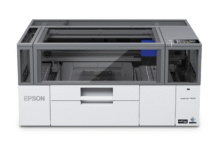Business operations at Heidelberger Druckmaschinen AG (Heidelberg) during the financial year 2019-20 (1 April 2019 to 31 March 2020) was impacted by the increasingly deteriorating economic environment caused by the COVID-19 pandemic.
Based on preliminary figures yet to be audited, Group sales amounted to EUR 2,349 million, some 6% down on the previous year. According to the company, restrained investment activity caused by the economic circumstances had a negative impact on business, first and foremost in Europe. During the fourth quarter, macroeconomic conditions worsened considerably and unexpectedly due to the Covid-19 pandemic and this was clearly reflected in sales, which at EUE 659 million were significantly lower than in the same quarter of the previous year (EUR 797 million).
The preliminary operating result (EBITDA) excluding the effects of restructuring was EUR 102 million, after being EUR 180 million in the previous year. The EBITDA margin excluding the effects of restructuring thus reached 4.3% and was below the previous year’s figure of 7.2% due to volume and product mix effects. Furthermore, the non-recurring expenditure for the company’s realignment (EUR 275 million) impacted the result for the financial year under review as planned. The provisional net result after taxes was thus EUR –343 million (previous year: EUR 21 million).
“Financial year 2019/20 was shaped by a significant downturn in the global economic climate, and that affected our customers and Heidelberg itself, too. Through our package of measures which we have announced in March, we have paved the way for Heidelberg to achieve stability, improve our liquidity, and increase profitability step by step for the long term. The Covid-19 pandemic poses significant challenges for Heidelberg and the entire industry, which we will master alongside our customers and using what Heidelberg has to offer as a technology leader in the printing industry. By joining forces, we will emerge stronger from the crisis,” says Rainer Hundsdörfer, CEO of Heidelberg.
To counteract the downturn in underlying conditions over the year and increase financial stability, Heidelberg had already agreed on a comprehensive package of measures in mid-March 2020. On the one hand, it includes an increase in liquidity and a significant reduction in net debt due to the almost complete retransfer of around EUR 380 million from the trust assets of Heidelberg Pension-Trust e.V., which was established in 2005.
As a result, net debt was significantly reduced to EUR 43 million at the end of March 2020 (previous year: EUR 250 million). On the other hand, profitability is being increased on a sustainable basis by lowering production and structural costs. This involves ensuring a consistent focus on profitable core business – including ending the production of Primefire and large-format presses – and the planned reduction in personnel.
“This considerable improvement in our liquidity gives us essential room for maneuver in these difficult times. Heidelberg is going to implement the announced measures consistently and quickly. We are all aware that the cuts are a significant blow, particularly in the current situation. However, they are absolutely essential to safeguarding the future of Heidelberg,” says Heidelberg CFO Marcus A. Wassenberg.
The negotiations on the implementation of the package of measures have largely been concluded with the employee representatives. The agreement has been reached in particular on the instruments of partial retirement and the establishment of a transfer company. The final consultations will focus on further detailing the implementation of the measures for all German sites and on concluding the agreements shortly.
The company will publish its financial statements and the Annual Report for 2019-20 on 9 June 2020.
















